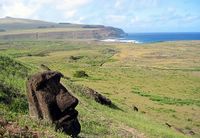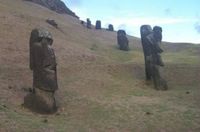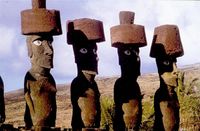Lorax Hall of Shame: Easter Island
My gloomy current read is Collapse: How Societies Choose to Fail or Succeed by Jared Diamond, Pulitzer Prize winning author of "Guns, Germs, and Steel." Everybody should read it. Here's Cliff-notes coverage of one section.
Easter, a 66 square mile volcanic island, is the most remote place in the world, being separated by 1,300 miles from the nearest island and by 2,300 miles from Chile's mainland. Radiocarbon dating suggests it was settled around 900 C.E. At its peak the population was 15,000-30,000 people.
 In 1722 the Dutchman Jacob Roggeveen marvelled, as everyone does, at the hundreds of gigantic stone statues (up to 270 tons and 70 feet tall) scattered across the barren countryside. Noting that the isolated islanders had only tiny, leaky canoes, he wondered how colonization had taken place. Also noting there was not even one tree anywhere on Easter's 66 square miles, he wrote:
In 1722 the Dutchman Jacob Roggeveen marvelled, as everyone does, at the hundreds of gigantic stone statues (up to 270 tons and 70 feet tall) scattered across the barren countryside. Noting that the isolated islanders had only tiny, leaky canoes, he wondered how colonization had taken place. Also noting there was not even one tree anywhere on Easter's 66 square miles, he wrote:The Easter Island he saw was a wretched place:"We could not comprehend how it was possible that these people, who are devoid of heavy thick timber for making any machines, as well as strong ropes, nevertheless had been able to erect such images..."
"We counted as sand the withered grass, hay, or other scorched and burnt vegetation, because its wasted appearance could give no other impression than of a singular poverty and barrenness."Over the centuries many wondered how the huge statues had been transported and erected; finally Thor Heyerdahl (of Kon-Tiki fame) ASKED the islanders.
"They were indignant that archaeologists had never deigned to ask them, and they erected a statue for him without a crane to prove their point."
 They used stones, logs, and ropes to do the job. Unless you prefer the aliens-from-outer-space theory, it seems the statue thing required (a) huge amounts of fibrous tree bark for long thick ropes and (b) big trees for sleds, rollers, ladders, and levers. Well, WHAT trees?
They used stones, logs, and ropes to do the job. Unless you prefer the aliens-from-outer-space theory, it seems the statue thing required (a) huge amounts of fibrous tree bark for long thick ropes and (b) big trees for sleds, rollers, ladders, and levers. Well, WHAT trees?Scientists have pieced together an answer. Pollen analysis, fossilized palm nuts, and casts of palm trunks in ancient lava prove the former presence of a unique Easter Island palm with diameters exceeding seven feet; it was, in its day, the largest palm in the world.
Pollen of five other palms has been found at Easter, and charcoal recovered from ancient fires matches 16 other now-extinct species. It seems Easter once supported a diverse forest, with trees up to 100 feet tall being regularly felled to supply the islanders with things like firewood, canoes, timber and rope, cloth, harpoons and carving, and fuel for thousands of extravagant cremations. Farms also entailed massive clearing.
 Deforestation began shortly after the colonists arrived. It led to soil erosion by rain and wind. Crops deteriorated when they were no longer grown under the palm trees that had shaded and protected them -- and the soil -- from fierce sun, evaporation, wind, and hard rains. Without trees, farmers no longer had the plant leaves, fruit and twigs they had used as compost; desiccation and nutrient leaching ensued. Erosion drove soil and minerals downhill, burying statues, settlements, and gardens.
Deforestation began shortly after the colonists arrived. It led to soil erosion by rain and wind. Crops deteriorated when they were no longer grown under the palm trees that had shaded and protected them -- and the soil -- from fierce sun, evaporation, wind, and hard rains. Without trees, farmers no longer had the plant leaves, fruit and twigs they had used as compost; desiccation and nutrient leaching ensued. Erosion drove soil and minerals downhill, burying statues, settlements, and gardens. Research indicates the very last of the palms, which had thrived on Easter for several hundred thousand years before man arrived, were cut down sometime before the seventeenth century. By then, deforestation had forced the upland plantations to be abandoned and the statue industry to end; angry tribes who had once one-upped each other with larger and larger statues now found their satisfaction in toppling and breaking the old ones. The last standing statue was toppled and broken in 1840. (In the modern era, cranes have put them back on their feet -- the tourists like them better that way.)
Research indicates the very last of the palms, which had thrived on Easter for several hundred thousand years before man arrived, were cut down sometime before the seventeenth century. By then, deforestation had forced the upland plantations to be abandoned and the statue industry to end; angry tribes who had once one-upped each other with larger and larger statues now found their satisfaction in toppling and breaking the old ones. The last standing statue was toppled and broken in 1840. (In the modern era, cranes have put them back on their feet -- the tourists like them better that way.)Bird and other vertebrate bones (found in early middens) prove that Easter, which today supports not one native land bird, was once home to at least six. It also had at least 25 nesting seabirds; its lack of predators (until humans arrived) had made it the richest breeding site in Polynesia.
Over time middens show many food sources vanishing from the diet, as species were exterminated and as a dwindling stock of trees for seaworthy canoes precluded ocean fishing for porpoise and other fish once a primary food of the islanders.
 Most sources of wild food were lost. Land birds disappeared completely, seabirds were reduced to tiny populations. Shellfish over time became less numerous and smaller (due to "preferential over-harvesting of larger individuals"). The only unflaggingly available food source: rats.
Most sources of wild food were lost. Land birds disappeared completely, seabirds were reduced to tiny populations. Shellfish over time became less numerous and smaller (due to "preferential over-harvesting of larger individuals"). The only unflaggingly available food source: rats."Easter's formerly complexly integrated society collapsed in an epidemic of civil war." I'm not going to describe the starvation and cannibalism which followed.
 In the 1870s Chile annexed Easter, which became a sheep ranch. Grazing by sheep, goats and horses caused further soil erosion and eliminated most of what had remained of the native vegetation. In the 1870s, there were 111 islanders left.
In the 1870s Chile annexed Easter, which became a sheep ranch. Grazing by sheep, goats and horses caused further soil erosion and eliminated most of what had remained of the native vegetation. In the 1870s, there were 111 islanders left.| UPDATE: Sigmund, Carl and Alfred have taken exception (on their site and also in the comments here) with aspects of this abstract and especially with one of the posted comments (which is quoted by the comment-leaver, NOT from Diamond's book, but from this website: different author, different tack). I am well aware there are many complex issues involved in conservation and lack thereof, and I am not an expert. The Lorax Hall of Shame award, in its purest form, is simply given to those who, face to face with the last of something, take it, even knowing there will be no more. As a fisherman said about using radar to pick off the last populations of cod on Georges Bank: "If somebody is going to get the last fish, it's going to be me." The further ahead one is able to look, the sooner one realizes this point has arrived. In my opinion, we're there. |
Technorati Tags: History, Folly, Environment, Farming, Logging












13 Comments:
"On an island as small as Easter, it was easy to see the effects of the deforestation as it was taking place. But the inhabitants continued their destructive actions. They probably prayed to their gods to replenish the land so they could continue to rape it, but the gods didn't answer. And still the trees came down. Whatever one did to alter that ecosystem, the results were reasonably predictable. One could stand on the summit and see almost every point on the island. The person who felled the last tree could see that it was the last tree. Nonetheless, he (or she) still felled it."
...
Funny, I am reading it, too. Currently on the Anasazi chapter.
Last year I read an excellent NOVEL called "Easter Island" by Jennifer Vanderbes and it is full of detail that Diamond talks about.
So the Islanders felled the last tree.
Perhaps the wood was needed to stay warm, or needed for cooking, or needed to build a raft, so supplies could be brought in, or escape facilitated.
I'm sorry, but I don't see the connection between Easter Islanders and the not so subtle message of todays deforestation as being equivalent.
As a matter of fact, I find the idea ludicrous. There are far better arguments to be made against deforestation than that silly one. Using that kind of argument only makes real conservationists look like idiots- and they have enough to deal with without carrying that baggage.
I think, Sigmund and company, the point is that people are, over and over again, willing to use up the very last bit of whatever there is - even if that means there won't be any more. I did it myself just recently - I gave away the very last copy I had of a book I wrote once. Then, too late, I realized I don't even have a proof copy of it. Oh well, too late.
Thanks for the mini-lessons you give nearly everyday. I appreciate the education!
Meli, that's what abe books are for.
Also, I understand the point you wish to make- but as I said, I do believe there are better ways to make it.
I am as concerned with environmental issues as anyone- but, just as there is science and mathematics in music. there must be the same for making a cogent argument in anything else.
The same type of irrational arguments are used by everyone from Holocaust deniers and conspiracy theorists. History, and their version of it, is either used or revised to fit a particular agenda.
i am dying to read the book :)
First let me say that THIS is a wonderful post Melinana and it quickly made me wish to look up more about the book.
With my immediate interest in the book I ask this question:
Robert S. Desowitz said that "it (the book) may well become a seminal work, although its plea for societal survival through ecological conservation is rather like preaching to the choir."
Do you agree? Is it a work that can change the ideas and actions of a person who is not already concerned about ecological conservation?
Despite the "gloomy" reference that you made would you recommend it to a friend...a friend named Michele perhaps?
Michele, I would definitely recommend this book to you or anyone. As for changing minds - I fear we live in an age when nobody wants to change his/her mind about anything. The divide seems so vast. Red and blue sometimes seem as far apart as grey and blue did at one time. I despair about reasonable discourse in our country. ?? But what can we do. Just keep trying.
Thank you for your reply. After only "knowing" you via your blog for a short while I already feel as if your book suggestion(s) should be heeded.
I agree with your assesment about the unwillingness of many to even consider changing theri mind. Yet, I KNOW that I know so very little and the more I "know" the more I want ot know. I LOVE having my mind changed.
So, I will be purchasing this book this week. Thank you.
Interesting piece on the island, and I agree the deforestation and resulting strife is atrocious, but you fail greatly to mention that the island today is inhabited and has modern conveniences such as cars, stores, roads, etc.
You are only showing one side of the beautiful island...the side with the moai. Please don't neglect that this island is today inhabited and does allow tourism. I was treated very well by the people and found them gracious hosts.
Perhaps you will someday visit and see for yourself? Out of its horrific history has come a gentle, caring people who welcome those from other nations with open arms.
Most of the information considered here do not agree with archeological findings. The Climate changes due to "The Little Ice Age" are not considered. In order to get modern information I recommend to read the blog: ipeliae.blogspot.com, or buy the book "Isla de Pascua, Europa y La Pequeña Edad del Hielo"
I was told some time ago that the east end of Molokai had a goat problem and they pretty much dried up the main water source on the island. No trees, no understory, no mulch. Basically the 'sponge' was damaged. They figured it out though and the goats were gotten rid of, trees grew back, sponge healed, water once again flowed. I heard they were considering repairing the west end so it would produce springs. The goat story was told to me in the mid 70's when I lived there. They were closing down the pineapple plantations back then.
The 'man cuts tree' problem is an old problem. I expect we have created many many deserts.
Post a Comment
<< Home